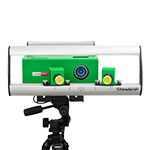RangeVision RV 3D Standard
 The RangeVision RV 3D Standard 3D scanner is a fast, innovative, and accurate 3D scanning unit with excellent capabilities and a wide range of uses. The Standard is the least expensive and least capable in a line of three extremely capable scanners. Even with its “little brother” status, it packs a good punch, especially for the price. The uses for this scanner are flexible, as well as endless. There are many reasons that this scanner was included in our iReviews list of 2014 best 3D Scanners under $10,000.
The RangeVision RV 3D Standard 3D scanner is a fast, innovative, and accurate 3D scanning unit with excellent capabilities and a wide range of uses. The Standard is the least expensive and least capable in a line of three extremely capable scanners. Even with its “little brother” status, it packs a good punch, especially for the price. The uses for this scanner are flexible, as well as endless. There are many reasons that this scanner was included in our iReviews list of 2014 best 3D Scanners under $10,000.
RangeVision is a company founded with a great deal of experience in the 3D industry. Using this experience, RangeVision develops and tests their own products. The notches on their belt translate to innovation, quality, and affordability for customers. RangeVision not only produces scanners but innovative software to accompany them. With excellent customer service, innovative products, and a vision for the future, RangeVision is destined to become one of the front-runners in the 3D scanning industry.
The RV 3D Standard uses a projector and collector setup to sense the scanned object and collect geometry data. Employing a structured light system, the projector produces many small bands of light onto an object. The object distorts the structure of the light bands, and the collector interprets them. The distortions are then processed as geometric data. A halogen light source produces the light that is projected onto objects. Halogen light is extremely bright, but retains coolness and softness enough to not be troublesome to the eyes. This makes halogen light a great candidate for use in the RV 3D Standard.
One of the best features of this unit is its ability to offer you different methods of aligning your 3D scan data. The RV 3D Standard gives you the ability to scan with or without point markers to align your untethered scans. Obviously, the most accurate way to accomplish data joining is to use these point markers, but there are some instances where they are not needed or would otherwise not be used. Further, the RV 3D Standard can employ a turntable that is fully integrated with the RV software to scan your objects and keep your data straight.
Data collection with this scanner is quick and accurate. In around seven seconds, you can have a full scan with 1 million points of triangulation. The 0.085mm point accuracy is provided by a 0.35mm resolution 1.3megapixel scanner lens. This versatility is amplified by a wide scan size. The RV 3D Standard handles many scan sizes in one unit, with a range from 5cm to 1m of scanning ability. This, of course, is stretched even further with the ability to match point markers and join smaller scans into a larger data sets. The scanner handles most data well, but very fine intricacies in texture and dark, non-reflective surfaces do not fare well with the data collector lens.
Software is included with the RV 3D Standard, and it is simple to use and comprehensive. The software’s algorithms are based on the principles of structured light, and match up excellently with the associated hardware. The software also controls the turntable and the integration thereof, which makes scanning smaller object extremely easy and keeps these scans accurate. Exported in STL format, the data collected can be used for a multitude of CAD and 3D printing applications.
The RV 3D Standard comes with an optional medium sized tripod for ultimate transportability. This protective suitcase is compartmentalized with heavy foam for a high degree of protection, which is excellent, because the scanner is encased in plastic, instead of metal, like many of its contemporaries. This case does, however, allow you to get out and scan, without being tied to a workspace. With a total weight of 15.5lbs, you are not hindered by toting around super massive pieces of equipment. The scanner also comes with a tripod, which is one of the lesser enjoyed features of some 3Ders. On the bright side, the tripod adds to an already large list of applications for which the RV 3D Standard can be used.
Overall, the RV 3D Standard is a great 3D scanner with a great price point. The standout factor of this unit was the innovation involved with being able to use it for turntable scanning, as well as free scanning. This scanner was developed with historical and artifact preservation in mind, but we can see it being a great fit for all types of reverse engineering, prototyping, and industrial design, as well as many others. It is also a great fit to round out our list of iReviews 2014 best 3D scanners under $10,000.
Related YouTube videos:
